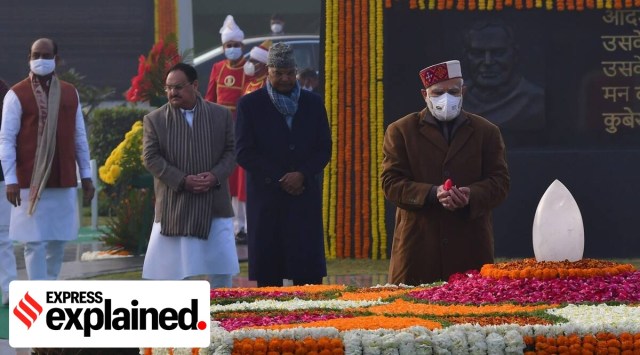Latest Comment
Post Comment
Read Comments
 PM Narendra Modi paid his tributes on the birth anniversary of late former PM Atal Bihari Vajpayee. (Express Photo by Amit Mehra)
PM Narendra Modi paid his tributes on the birth anniversary of late former PM Atal Bihari Vajpayee. (Express Photo by Amit Mehra) In 2014, the then newly-elected Narendra Modi government announced that December 25 would be celebrated as “Good Governance Day.” Marking the birth anniversary of former Prime Minister and Bharatiya Janata Party doyen Atal Bihari Vajpayee, the day is meant to foster awareness among citizens about government accountability and administration.
At the time of its announcement, the date chosen (December 25) drew criticism due the the occasion clashing with Christmas.
We take a look at what Good Governance Day entails, the man whose birth anniversary was chosen to mark the event, and some criticism that it has received in the past.
Atal Bihari Vajpayee: a foundational figure for the BJP
Atal Bihari Vajpayee was born on December 25, 1924 in Gwalior, present-day Madhya Pradesh. A poet-politician, he joined the Rashtriya Swayamsevak Sangh (RSS) in 1939, becoming a pracharak (full-time worker) in 1947. Due to his literary prowess, he began working under Sangh Parivar head Deen Dayal Upadhyaya on various publications.
After Upadhyaya’s passing, in 1968, he became the national president of the Jana Sangh, RSS’s new political outfit. He was the most eloquent speaker that the Hindu right had at that time and soon proved himself to be a capable administrator as well. He held his first major national position as the External Affairs Minister in Morarji’s post Emergency government in 1975. While that government soon fell (in 1977), Vajpayee had earned major plaudits for his tenure, with his UN General Assembly speech in Hindi drawing praise from all quarters.
In 1980, erstwhile members of the Jana Sangh coalesced to form the BJP with Vajpayee as its leader. While the party initially struggled for electoral success, by the 1990s, religious polarisation orchestrated by the party and other Hindu outfits started making electoral inroads for the BJP.
An able administrator
While he first became Prime Minister in 1996 (for 16 days) it was his 1998-1999 and 1999-2004 terms that left a lasting impact on the nation.
Vajpayee expertly toed a line between hardline Hindutva and moderate Hindu nationalism while governing efficiently. Under his tenure, India formally became a nuclear power despite significant criticism from the West, ably faced war and peace with Pakistan, undertook massive public welfare projects including Sarva Shikshya Abhiyaan and PM Gramin Sadak Yojana, and ushered in a new era of foreign investment and international relations, especially with the US.
Celebrating Vajpayee’s contributions
When Prime Minister Narendra Modi announced the new “Good Governance Day” in 2014, there were two primary reasons cited. First was to commemorate the life of Atal Bihari Vajpayee, who at the time was very sick. Vajpayee was not just a “good governor” but also one of the foundational figures of the BJP and an icon for the party.
As PM Modi tweeted today, “Tributes to Atal Ji on his Jayanti. His contribution to India is indelible. His leadership and vision motivate millions of people.” Former vice-President Venkiah Naidu said, “Atalji was a visionary reformer who fast-tracked all-round development.”
Good Governance through e-Governance
Second, was to use the day as a way to increase awareness of government services and accountability among people and inculcate “good governance” as a habit for civil servants. The day is celebrated to ensure that the country’s residents are treated fairly by the government and they receive advantages of various government services.
A major push, in this regard, was to promote “e-Governance” with the official slogan for the event being “Good Governance through e-Governance.” According to the Good Governance Day Report published in 2014 by the Ministry of Communication and Information Technology, “Highlighting the key achievements and activities of the ministry that have played an instrumental role in furthering the cause of Good Governance… (and) showcasing of technologies and solutions by the government and the industry, instrumental in the Digital India programme” are two crucial objectives for the day.
In 2019, the government launched the Good Governance Index on this occasion. The GGI is a scientifically prepared tool based on various parameters of good governance which assess the level of any state at a given point of time and help in shaping future development.
Christmas controversy
There was some unhappiness due to the clash of Good Governance Day with Christmas, with some claiming that the BJP intentionally chose the day to overshadow Christmas celebrations. They were particularly critical of the fact that the day was converted into a working day for public servants with many functions organised that would require their attendance.
In response, the government diplomatically made December 25’s activities a “voluntary exercise”, allowing those who want to, to stay at home and celebrate Christmas.
Of late Narendra Modi has also repeatedly invoked Jesus Christ in his speeches on Good Governance Day. On Man ki Baat, Modi said today that “it is a day to remember the life and teaching of Jesus Christ.”